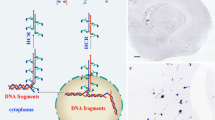Abstract
Different approaches to the in-situ polymerase chain reaction (in-situ PCR) were compared in the detection and in-situ localization of chromosomal translocations (t14; 18) immunoglobulin gene rearrangements and viral DNA (cytomegalovirus, hepatitis B-virus) in cell suspensions, cytospins and tissue sections. Single and multiple primer pairs were compared in the amplification step of indirect in-situ PCR and long genomic probes or internal oligonucleotide probes in the subsequent in-situ hybridization (ISH). For direct in-situ PCR, in which amplification products were directly labeled with digoxigen-in-11-dUTP during PCR and detected immunohistochemically, only single primer pairs were used for amplification. In-situ PCR yielded best results in the cell suspensions and worked less efficiently in cytospins or tissue sections. Quantification of the results obtained in artificial cell mixtures yielded only an approximate correlation between the number of expected and observed positive cells. The specificity of the results was greater with indirect in-situ PCR than direct in-situ PCR, where false positive results were frequent. Successful indirect in-situ PCR in tissue sections required the use of multiple primer pairs for amplification and genomic probes for detection by ISH. False positive results in direct in-situ PCR were caused by primer-independent, but DNA polymeraseand cycling-dependent incorporation of digoxigenin-labeled nucleotides into cellular DNA, possibly related to DNA repair and/or internal priming. Non-specific results were most marked in tissue sections and were much less frequent in cell suspensions. In-situ PCR includes a number of different techniques, which are not equally applicable to different starting materials. Accurate interpretation of the results requires vigorous controls.
Similar content being viewed by others
References
Bagasra O, Hauptman SP, Lischner HW, Sachs M, Pomerantz RJ (1992) Detection of human immunodeficiency virus type 1 provirus in mononuclear cells by in situ polymerase chain reaction. N Engl J Med 326:1385–91
Baginski I, Ferrie A, Watson R, Mack D (1990) Detection of hepatitis B virus. In: Innis MA, Gelfand DH, Sninsky JJ, White TJ (eds) PCR protocols, a guide to methods and applications. Academic Press, San Diego, pp 348–355
Brigati D, Myerson D, Leary JJ, Spalholz B, Travis SZ, Fong CKY, Hsiung GD, Ward DC (1983) Detection of viral genomes in cultured cells and paraffin-embedded tissue sections using biotin-labelled hybridization probes. Virology 38:470
Chiu KP, Cohen SH, Morris DW, Jordan GW (1992) Intracellular amplification of proviral DNA in tissue sections using the polymerase chain reaction. J Histochem Cytochem 40:333–341
Demmler GJ, Buffone GJ, Schimbor CM, May RA (1988) Detection of Cytomegalovirus in urine from newborns using polymerase chain reaction. J Infect Dis 158:1177–1184
Erlich HA, Gelfand D, Sninsky JJ (1991) Recent advances in the polymerase chain reaction. Science 252:1643–1651
Furuta Y, Shinohara T, Sano K, Meguro M, Nagashima K (1990) In-situ hybridization with digoxigenin-labelled DNA probes for detection of viral genomes. J Clin Pathol 43:806–809
Haase AT, Retzel EF, Staskus KA (1990) Amplification and detection of lentiviral DNA inside cells. Proc Natl Acad Sci USA 87:4971–4975
Komminoth P (1992) Digoxigenin as an alternative probe labeling for in-situ hybridization. Diagn Mol Pathol 1:142–150
Komminoth P, Long AA, Ray R, Wolfe HJ (1992a) In situ polymerase chain reaction detection of viral DNA, single copy genes and gene rearrangments in cell suspensions and cytospins. Diagn Mol Pathol 1:85–97
Komminoth P, Merk FB, Leav I, Wolfe HJ, Roth J (1992b) Comparison of35S- and digoxigenin-labeled RNA and oligonucleotide probes for in situ hybridization. Expression of mRNA of the seminal vesicle secretion protein II and androgen receptor genes in the rat prostate. Histochemistry 98:217–228
Liang TJ, Blum HE, Wands JR (1990) Characterisation and biological properties of a hepatitis B virus isolated from a patient without hepatitis B virus serologic markers. Hepatology 12:204–212
Liu AH, Creadon G, Wysocki LJ (1992) Sequencing heavy-and light-chain variable region genes of single B-hybridoma cells by total enzymatic amplification. Proc Natl Acad Sci USA 89:7610–7614
Long AA, Komminoth P, Wolf HJ (1992a) Detection of HIV provirus by in situ polymerase chain reaction (letter). N Engl Med J 327:1529
Long AA, Mueller J, Andre-Schwartz J, Barrett KJ, Schwartz R, Wolfe HJ (1992b) High-specificity in-situ hybridization: methods and application. Diagn Mol Pathol 1:45–57
Nuovo GJ, Gallery F, MacConnell P, Becker J, Bloch W (1991a) An improved technique for the in situ detection of DNA after polymerase chain reaction amplification. Am J Pathol 139:1239–1244
Nuovo GJ, MacConnell P, Forde A, Delvenne Ph (1991b) Detection of human papillomavirus DNA in formalin-fixed tissues by in situ hybridization after amplification by polymerase chain reaction. Am J Pathol 139:847–854
Nuovo GJ, Margiotta M, MacConnell P, Becker J (1992) Rapid in situ detection of PCR-amplified HIV-1 DNA. Diagn Mol Pathol 1:98–102
Ray R, Komminoth P, Machado M, Wolfe HJ (1991) Combined polymerase chain reaction and in-situ hybridization for the detection of single copy genes and viral genomic sequences in intact cells. Modern Pathol 4:124
Schoenfeld Y, Hsu-Lin SC, Gabriels JE, Silberstein LE, Furie BC, Furie B, Stollar BD, Schwartz RS (1982) Production of autoantibodies by human-human hybridomas. J Clin Invest 70:205–208
Schoenfeld Y, Rauch J, Massicotte H, Datta SK, Andre-Schwartz J, Stollar D, Schwartz RS (1983) Polyspecificity of monoclonal lupus autoantibodies produced by human-human hybridomas. New Engl J Med 308:414–420
Shibata D, Klatt EC (1989) Analysis of human immunodeficiency virus and cytomegalovirus infection by polymerase chain reaction in the acquired immunodeficiency syndrome. Arch Pathol Lab Med 113:1239–1244
Shibata D, Martin WJ, Appleman MD, Causey DM, Leedom JM, Arnheim N (1988) Detection of cytomegalovirus DNA in peripheral blood of patients infected with human immunodeficiency virus. J Infect Dis 158:1185–1192
Staskus KA, Couch L, Bitterman P, Retzel EF, Zupancic M, List J, Haase AT (1991) In situ amplification of visna virus DNA in tissue sections a reservoir of latently infected cells. Microbial Pathogenesis 11:67–76
Author information
Authors and Affiliations
Rights and permissions
About this article
Cite this article
Long, A.A., Komminoth, P., Lee, E. et al. Comparison of indirect and direct in-situ polymerase chain reaction in cell preparations and tissue sections. Histochemistry 99, 151–162 (1993). https://doi.org/10.1007/BF00571876
Accepted:
Issue Date:
DOI: https://doi.org/10.1007/BF00571876




